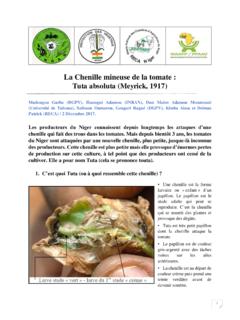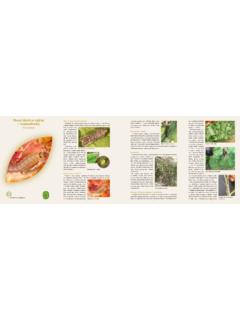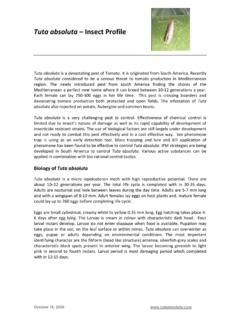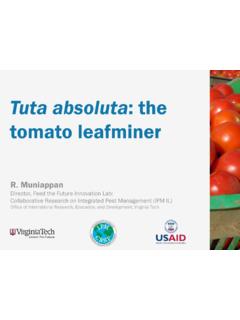Transcription of BIOASSAY METHOD FOR TOXICITY STUDIES OF INSECTICIDE ...
1 BIOASSAY METHOD for TOXICITY nc. agrotec., Lavras, v. 35, n. 5, p. 869-877, , 2011 BIOASSAY METHOD FOR TOXICITY STUDIES OF INSECTICIDEFORMULATIONS TO Tuta absoluta (MEYRICK, 1917)Metodologia de bioensaio para estudos de toxicidade de formula escomerciais de inseticidas a Tuta absoluta (Meyrick, 1917)Tarc sio Visintin da Silva Galdino1, Marcelo Coutinho Pican o2, Elisangela Gomes Fidelis de Morais3,Nilson Rodrigues Silva2, Geverson Aelton Rezende da Silva2, Mayara Cristina Lopes2 ABSTRACTC hemical control is the main METHOD for controlling the tomato leafminer, Tuta absoluta (MEYRICK, 1917) (Lepidoptera:Gelechiidae).
2 Reported techniques for the evaluation of INSECTICIDE TOXICITY to the tomato leafminer are not in agreement with fieldconditions and do not allow us to verify whether doses used in the field are efficient for control. Thus, the objective of this work wasto develop a BIOASSAY methodology to study the TOXICITY of INSECTICIDE formulations to T. absoluta that represent field conditions forfast-acting insecticides (neurotoxics and inhibitors of respiration) and slow-acting insecticides (Bacillus thuringiensis and insectgrowth regulators).
3 The leaf-dip METHOD was the most efficient METHOD for TOXICITY STUDIES of insecticides formulations to T. verified that bioassays with fast-acting insecticides should be performed with glass Petri dishes containing one tomato foliolefrom the 4th leaf from the plant apex infested with 10 larvae of 3rd instar and these bioassays can last 48 hours. Conversely, bioassayswith slow-acting insecticides should be performed with two-liter transparent PET bottles containing the 4th leaf from the plant apex,with their petioles immersed in a glass bottle containing 120 mL of water, and this leaf should be infested with 10 larvae of 2nd instarand this bioassays can last seven terms.
4 Susceptibility, tomato leafminer, chemical control, BIOASSAY standardization, resistance principal m todo utilizado no controle da tra a-do-tomateiro Tuta absoluta (MEYRICK, 1917) (Lepidoptera: Gelechiidae) a aplica o de inseticidas. As t cnicas atuais de avalia o da toxicidade de inseticidas sobre essa praga n o simulam a situa o decampo e n o possibilitam a verifica o se as doses usadas no campo s o eficientes no seu controle. Assim, neste trabalho, objetivou-se desenvolver uma metodologia que represente as condi es de campo para inseticidas de a o r pida (neurot xicos e inibidoresrespirat rios) e de a o lenta (Bacillus thuringiensis e reguladores de crescimento.)
5 A metodologia mais eficiente para estudos detoxicidade de formula es comerciais a T. absoluta foi a imers o de folhas em calda inseticida. Para os bioensaios de inseticidas de a or pida, sugere-se que estes sejam realizados em placas de Petri, contendo fol olos de tomate da 4 folha a partir do pice da planta,infestados com 10 larvas de 3 nstar e eles podem durar 48 horas. Quanto aos bioensaios de toxicidade de inseticidas de a o lenta,sugere-se que sejam realizados em garrafas PET transparentes, de dois litros, contendo a 4 folha de tomate a partir do pice da plantainfestada com 10 larvas de 2 nstar e seu pec olo inserido em vidro de 120 mL contendo gua.
6 Nesse caso, o bioensaio pode durar setedias sem preju zo na efici para indexa o: Suscetibilidade, tra a-do-tomateiro, controle qu mico, padroniza o de bioensaio, levantamento de resist ncia.(Received in september 23, 2010 and approved in february 8, 2011)1 Universidade Federal de Vi osa/UFV Departamento de Biologia Animal/DBA Entomologia Avenida Peter Henry Rolfs, s/n, Campus Universit rio 36570-000 Vi osa, MG Federal de Vi osa/UFV Departamento de Biologia Animal/DBA Vi osa, MG3 Empresa Brasileira de Pesquisa Agropecu ria/ Embrapa Roraima Boa Vista, RRINTRODUCTIONThe tomato leafminer Tuta absoluta (MEYRICK, 1917)(Lepidoptera: Gelechiidae) originates from South America(GIORDANO.)
7 SILVA, 1999) and was recently introduced inEurope and North Africa (GARCIA; VERCHER, 2010). Thisinsect is a serious tomato pest, because its larvae mine theleaves and bore not only fruits but also stems (PICAN O etal., 1998 e 2007). Chemical control is the main control methodtowards T. absoluta (SIQUEIRA et al., 2000ab).Two kinds of insecticides are used for T. absolutacontrol: fast-acting and slow-acting. The fast-actinginsecticides are neurotoxics or respiration inhibitors. Theykill larvae two days after the application, including the lastinstars that are more tolerant to insecticides (LIU et al.
8 ,2002; WANG et al., 2009). The slow-acting insecticides areBacillus thuringiensis toxins and insect growth usually kill larvae of early instars in at least five days(FISK; WRIGHT, 1992; SILVA et al., 2003).GALDINO, T. V. da S. et nc. agrotec., Lavras, v. 35, n. 5, p. 869-877, , 2011 INSECTICIDE efficiency is evaluated by toxicitybioassays. The purpose of these bioassays is to selectnew biological or organosynthetic insecticides and theirmost appropriate doses that affect insects, as well as totest pest resistance (SIQUEIRA et al.
9 , 2000) and thepesticide selectivity to natural enemies (PICAN O et al.,2000; BACCI et al., 2009).The standard technique used in TOXICITY bioassaysis leaf immersion. This technique allows the product to beevenly distributed on the leaf surface and makes it possibleto check whether or not the field doses are effective for thepest control (BACCI et al., 2009). The few STUDIES ofinsecticide TOXICITY with T. absoluta have been carried outvia topical application on the insects bodies (LIETTI etal., 2005) or by putting the insects into contact with filterpaper s i m pr egna t ed wi th i nsecti ci de m ol ecul es(SALAZAR; ARAYA, 1997 e 2001; SIQUEIRA et al.
10 ,2000ab). These techniques do not represent field situationsand do not allow us to verify whether doses are beingapplied efficiently (BACCI et al., 2009).Therefore, the goal of this work was to develop abioassay methodology to study the TOXICITY of insecticideformulations on T. absoluta that corresponds to fieldcondi t ion s for bot h fa st -a cti n g a n d sl ow-a cti n AND METHODSB ioassays were performed at the Pest ManagementLaboratory from Federal University of Vi osa. Fiveexperiments were carried out to determine the mostappropriate methodology for TOXICITY bioassays ofinsecticides to T.

















